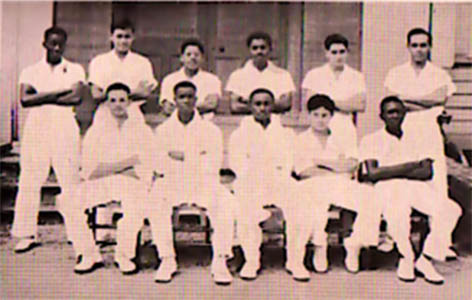Dear Editor,
‘Mens sana in corpore sanum’ – the original QC motto that must have become lost since the foreign language of ‘Latin’ was dropped from the education curriculum. So perhaps the lapse may be one reason why there seems not to be a more interactive relationship between the Ministries of Education and that of Culture, Youth and Sports, for neither would appreciate the translation ‘Healthy Mind in a Healthy Body’ – almost foreseeably related to the currently touted aspiration of ‘human development’. At Queenstown Roman Catholic Primary School, despite the greater proportion of male teachers, it was a Miss Fields who conducted regular ‘physical exercises’ before the start of morning classes. Later, between fourth and sixth standard, there were competitions between A, B and C Houses – cricket, football in Queenstown pasture next door, now occupied by St Gabriel’s Primary School. Out of this pasture emerged such greats as Cecil ‘Bruiser’ Thomas to represent British Guiana in cricket, football, hockey and table tennis. George Sohan became a prolific First Division batsman for the East Indian (now Everest) Cricket Club – all out of primary inter-school competition.
At Washington High School we competed with other private high schools – Central, Progressive, Enterprise, Indian Education Trust and others – in cricket and table tennis mostly. Then at Queen’s there was a range of sports that extricated our best talents – athletics, cricket, football, hockey, lawn and table tennis – not only amongst the six houses, but in competition with a number of other schools, outstanding amongst whom were St Stanislaus College (‘down the road in Brickdam’); and Berbice High School in New Amsterdam. The three were known for the annual cricket competition for the Jacob Cup. More active competition was however between the two Colleges, rivals in both First and Second Division Cricket. Out of Queen’s however emerged a host of champions’, several of whom performed at national and international levels. Notwithstanding their immediate preoccupations it may be informative to see what professional achievers several, amongst others, became:
Athletics
F.E. Mongul – Veterinary Surgeon
S.G. Klautky – Doctor of Medicine
E.B. John – Human Resources Director
Cricket
A.F.R. Bishop – Chancellor of the Judiciary; Law Professor, U.G.
R.A. Gibbons – Professor, Communications, NY University Fulbright Scholar
R.M. Glasford – Director, Sugar Factories, Booker Group, U.K.
L.A. Jackman – Attorney at Law
W.I. Lee – Doctor of Medicine
M. Ragbeer – Doctor of Medicine
C. Pilgrim – Guyana High Commissioner to the United Kingdom
F.E. Mongul – As above
E.B. John – As above
Football
A.F.R. Bishop – As above
M. Moore – Accountant
I. Leal – Permanent Secretary
Hockey
W. Chin – Doctor of Medicine
W.I. Lee – As above
I. Leal – As above
M. Moore – As above
Lawn Tennis
I. Leal – As above
Table Tennis
M. Moore – As above (also represented Canada)
There was of course a Games Master.
In those days, exams were set and marked by the Oxford and Cambridge Joint Board, who required not more than ten subjects at the Ordinary Level (including French, with Latin optional); and no more than four subjects at the Advanced Level – too few perhaps for such intellectual stalwarts of the same 1948 class – Shridath Ramphal, Forbes Burnham, Damodar Panday, Fred Wills, Rashleigh Jackson, Bertram Collins, and several more of that ilk. In addition, there were active Debating Competitions; as well as a dynamic Drama Group, the latter organized by the Senior Master in Mathematics and internationally acclaimed playwright, Norman E. Cameron, M.A. Cantab. All the above and families recognised the ‘holiday’ and attended the Queen’s College Annual Athletics Competition run off with pomp and ceremony, and of course speed, at the Georgetown Cricket Ground, Bourda, famous location for Test Cricket.
So that those surviving ‘alumni’ continue to ponder on why this fundamental component of ‘human development’ is now so persistently ignored, for it speaks profoundly to teamsmanship; to the better understanding of ‘self’ and ‘other’; to conceding loss and congratulating the winner; and hopefully in the end, bridging some of the communication gaps too often simplistically misinterpreted to be ‘ethnic’ – a hasty substitution for differences in intellectual perspectives. So once again there is opportunity for our Queen’s College Alumni (who must reflect on the implied discrimination against its Alumnae) to retrieve the mantle of leadership towards a creative path and objective goals of healing differences – by first opening up an appropriate conversation with the Ministries concerned, and in the process remind one another of the old truism – ‘mens sana in corpore sanum’. See picture below, from which I was absent.

Sitting: C.S. Pilgrim, A.F.R. Bishop, R.A. Gibbons (captain), W.L. Lee, L.A. Jackman, Absent: M. Moore, T.B. Richmond.Baird – a doctor of medicine who went on to practise in the USA.
Sincerely,
E.B. John
Prefect; Captain D’Urban House;
Winner, Short Story Competition –
First Edition of magazine The QC Lictor
